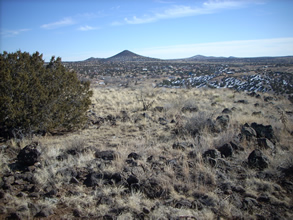
La Cienega Pueblo (LA 3)
Galisteo Basin Sites
- Lamy Jct
- Lower Arroyo Hondo Pueblo
- El Camino Real
- Chamisa Locita
- El Crestón
- Espinoso Ridge Pueblo
- La Cienega Pueblo (LA 3)
- La Cienega Pithouse Village
- La Cieneguilla Pueblo (LA 16)
- La Cieneguilla Petroglyphs
- Manzanares Pueblo
- Paa-ko
- Petroglyph Hill
- Pueblo Blanco
- Pueblo Colorado
- Pueblo Galisteo
- Pueblo Largo
- Pueblo San Cristóbal
- Pueblo San Lazaro
- Pueblo Shé
- Rote Chert Quarry
- San José de Las Huertas
- Upper Arroyo Hondo Pueblo
- Pueblo San Marcos
The La Cienega Pueblo and Petroglyphs site (LA 3), is also known as Pueblo Mesita and Pueblo Cienega.
The site is on a flat, basalt-capped mesa top that extends southwesterly from the base of Cerro Seguro to an isolated rock outcropping, or picacho, formed between and above the confluence of the Santa Fe River and La Cienega Creek. The site encompasses the majority of the mesa top, extends along the cliff below the mesa’s edge, and includes the hill slopes descending from the mesa to the Santa Fe River and La Cienega Creek
The site was originally investigated in 1915 by Nels C. Nelson of the American Museum of Natural History. Between 1971 and 1979, the School of American Research recorded the site as part of a 51,200-acre reconnaissance survey.
The site contains several prehistoric roomblocks,
depressions, petroglyphs, and other features; including a probable water
 catchment feature, a possible windbreak, and bedrock grinding slicks. In
addition, there is excellent potential for intact, buried cultural features to
occur on the mesa top setting that were not detected during the surface
inventory associated with the current investigations. Stone corrals, probably
historic, are also present. Prehistoric trails undoubtedly led from the mesa
top down to the La Cienega Creek and the Santa Fe River.
catchment feature, a possible windbreak, and bedrock grinding slicks. In
addition, there is excellent potential for intact, buried cultural features to
occur on the mesa top setting that were not detected during the surface
inventory associated with the current investigations. Stone corrals, probably
historic, are also present. Prehistoric trails undoubtedly led from the mesa
top down to the La Cienega Creek and the Santa Fe River.
Thousands of petroglyphs are present, represented in hundreds of petroglyph panels and isolated images. Most of the rock art is along the basalt cliff just below the mesa’s edge and concentrates heavily along this escarpment above La Cienega Creek. Images are also present in fewer numbers on boulders scattered on the hill slopes leading down to the Santa Fe River and La Cienega Creek. Most of the petroglyphs are prehistoric, with others dating to the Historic through Modern periods. The petroglyphs are pecked and scratched. Bird images are a common prehistoric rock art motif at the site. Other observed prehistoric images include animal figures, human figures, geometric shapes, hand prints, corn plants, and possible landscape features. Observed historic inscriptions include Spanish crosses, and a horse with rider.

© New Mexico Office of Archaeological Studies, a division of the New Mexico Department of Cultural Affairs.
The Center for New Mexico Archaeology
7 Old Cochiti Road
Santa Fe, NM 87507
505-476-4404
Fax: 505-476-4448

